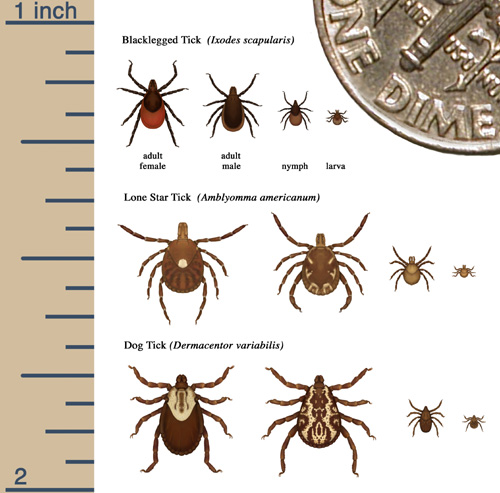Tick Tock: What you need to know about ticks in Northern Illinois

Instead of all the hoopla about the totally innocuous periodical cicada emergence, I wish the media would focus on something really important: Ticks.
I have had numerous people reporting that whether they are out in a nature area, or in their backyard, or even in their house, they are finding Nature’s little hitchhiker on them earlier and more every spring.
And unlike our furry family members — cats and dogs — we can’t just squirt a little tube on the back of our necks once a month and be free of fleas, ticks and parasites. I will dedicate another column to ticks and other pests that affect our pets. Today, it is all about us — and ticks.
Why is it important to know about ticks? There are several diseases that are transmitted to humans by the different ticks we have. One is “new” to us and has a very strange effect. More on that later.
And the ticks we have, are not only usually more prevalent in cool, wet springs, but due to Mother Nature turning up the thermostat — everywhere, Will County is definitely warmer. So, the bugs, weeds, diseases that lived south of mid-state, are now moving northward, and finding a home here — on us.
All ticks are parasites. They aren’t insects, but are in the family of spiders. Ticks are arthropods (8-legged, two body regions). Ticks feed on warm-blooded animals. They can’t fly (like many insects), nor can they hop (like fleas); their mode of transportation is, well, like hailing a cab. This host-seeking behavior is called questing. They hang out on tall grasses, or in trees, with their front legs reaching forward. When their next meal (like a squirrel, livestock, deer) walk by, they just grab on … like a Nature Hitchhiker.
Ticks have an incomplete life cycle. There are 4 stages: egg, larvae, nymph and adult. The larvae are about the size of a poppy seed; nymphs are the size of a grain of sand, and an adult tick is about the size of an apple seed. These are the sizes of ticks before they have their blood meal. Once they have eaten, they blow up like a semi-puffed-up balloon.
When it comes to eating, ticks take their time before dining; they look for the best seat in the house. Unlike mosquitoes that are more like going to a drive-in-in, bite, out and done, ticks can crawl around on a host for a few days before hunkering down. This is good news for us, because an unattached found tick has not had the opportunity to transmit a disease yet.
The three main ticks you will encounter in Northern Illinois are the American Dog Tick (sometimes called the dog tick), the Lone Star Tick and the Deer Tick (also known as the Black-legged Tick). The diagram above, from the Illinois Department of Public Health, is a great tick identification guide. There is also a tick called the Brown Dog Tick (also known as kennel tick) but it rarely affects humans.
The most prevalent diseases these ticks carry are different and have been known for years. Dog ticks and Lone Star ticks can transmit Rocky Mountain Spotted Fever, tularemia and possibly ehrlichiosis. The Lone Star tick is less likely to transmit Rocky Mountain Spotted Fever than the Dog Tick. Deer ticks transmit the bacteria that can cause human Lyme disease. But wait, there is more. And this, my friends, is a weird one.
In 2008, it was discovered in the Southern U.S. that the Lone Star Tick could cause a different problem — an allergic syndrome that caused allergy to red meat in humans. This was considered rare at the time, but as the incidence grew, so did the research and interest in learning more. I know 3 people (not all Illinoisians) who have had this.
The disease is called alpha gal, named for a sugar molecule that exists in all mammals except humans. The tick bite transfers this to humans, and for those sensitive, the body starts to make antibodies and 2-6 hours after eating red meat, the person can have a mild to a severe allergic reaction to red meat. This can last over a year and, for some people, longer.
So, what to do? If you find a tick, it is good to identify it. If it is hooked on you, it should be removed and kept for ID and possible testing. Ticks have to be connected to us for over 24 hours before disease is transmitted.
Removing ticks should be simple and straightforward. Pinch it behind the head with tweezers or the ever-so-handy tick remover tool, and its mouth will open, and it will release. Never, ever use Vaseline, or nail polish, or worse, a match. These are home remedies for something else, chiggers. Using any of these will make the situation worse, and the tick will dig in and go totally under your skin to escape.
What then? If you have any symptoms, which do not appear immediately, you can seek medical attention and be tested for antibodies that build up as a reaction to the tick bite. You can also have ticks tested.
But best yet, how to avoid ticks. Avoid their habitat, keep grass mowed or stay out of areas if you do not have protective clothing on. After being in possible tick areas, be sure to do a full body inspection.
It is easiest if you have a tick-check buddy to check your scalp and other areas you can’t see yourself.